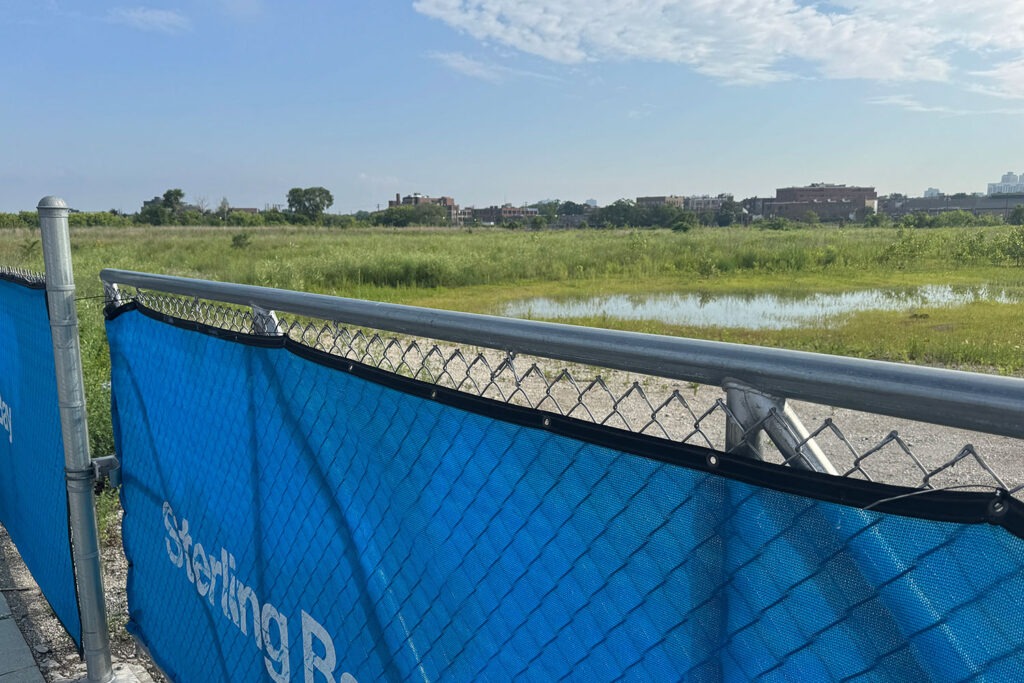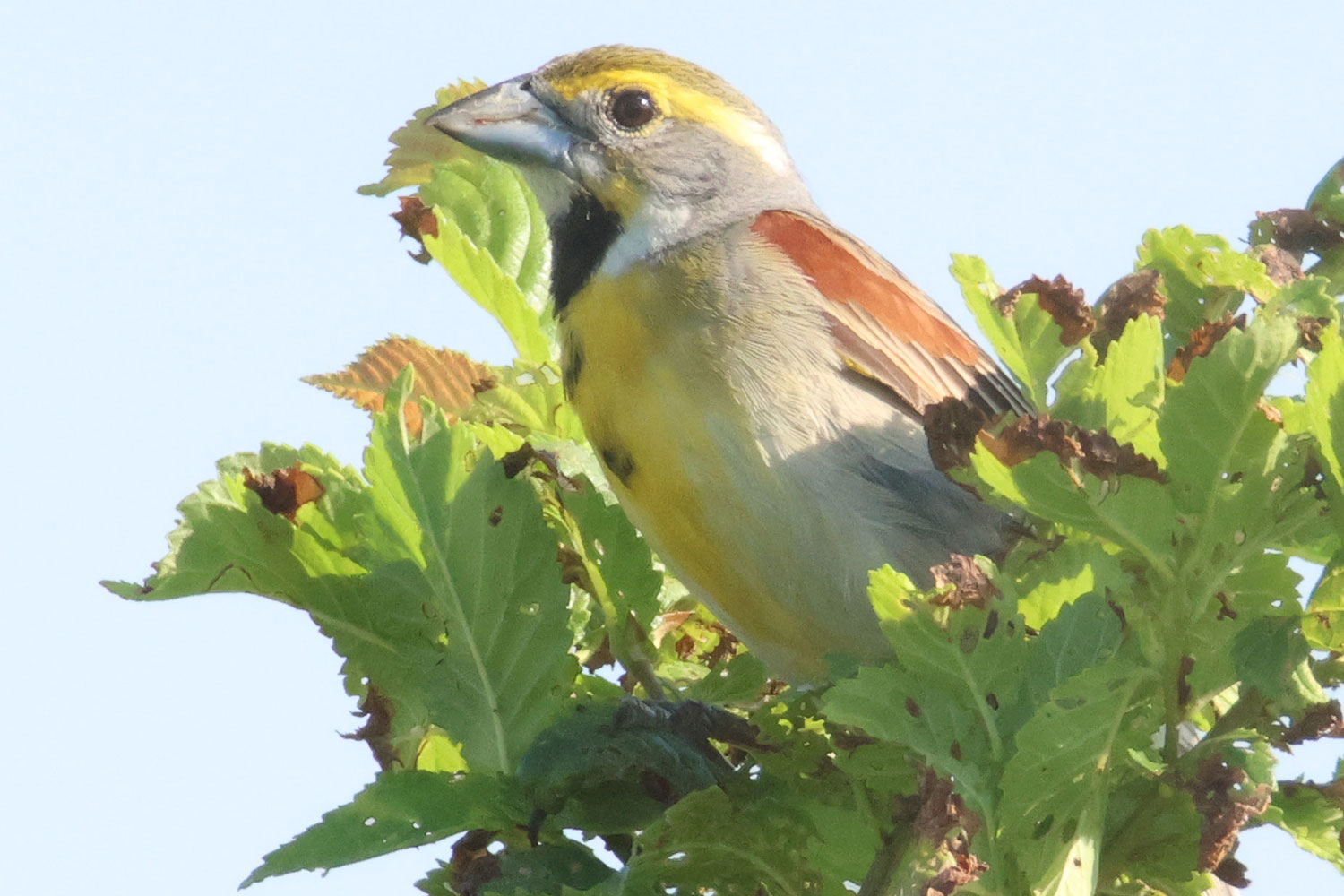As I headed to the Hideout on the evening of the summer solstice, I followed my usual route to the concert venue. I walked alongside the fenced-in vacant land where the Lincoln Yards megadevelopment was supposedly going to be built.
Nothing ever seems to change on the scrubby ground behind that chain-link fencing, which the Sterling Bay development company put up in 2019. It’s been years since I’ve noticed anything happening there at all, other than weeds growing.
But when I turned the corner from Throop Street onto Wabansia Avenue on June 21, I noticed a birdsong. I didn’t recognize it immediately, but I knew it was something different from the birds you’d expect to hear in that vicinity. It wasn’t just some gull or house sparrow. So, I opened the Merlin Bird ID app on my phone and started recording. And when the bird called out again, the app identified it as a dickcissel.
Now, if you aren’t a birder, you may have never heard of the dickcissel, a grasslands bird with a curious name. “Dickcissel” is an imitation of the sparrow-size bird’s tune. If you are a birder (as I am), you probably haven’t seen dickcissels all that often inside Chicago’s city limits. That’s why I was fascinated to hear one singing in this field of grass, weeds, and shrubs northeast of Wabansia and Ada Street — a location that used to be a filling station for city vehicles.
I returned the next morning with my camera and telephoto lens. Visual confirmation! I saw at least one dickcissel, with a lovely mix of yellow, black, and brown feathers. It was perched on a shrub behind the fence, singing away. I thought I saw a second dickcissel, too, but I wasn’t sure.
I eagerly shared the news of my sighting in a birding forum on the Discord social media platform. And several other birders flocked to this North Side corner to see the dickcissels with their own eyes. When I returned on July 9, a dickcissel was still there — three and a half weeks after I’d first heard one.
As it turned out, I wasn’t the first person who’d spotted dickcissels in this section of Lincoln Yards. Almost exactly one year earlier, Illinois Audubon Society board member Andrea Tolzmann and her son Simon drove past the same spot, with the windows of their car rolled down.
“I heard a dickcissel,” Simon recalls. “I was like, ‘Mom, you should pull over.’” Simon, who’s now 20, has been birding since he was 11. “I was pretty surprised to hear it so close to downtown, in a city where there’s seemingly no adequate prairie to house these grassland specialists. I was even more surprised to hear it coming from the construction site. I remember looking out and seeing invasive plants. I remember thinking: What does a dickcissel see here that it couldn’t get somewhere else? This is really, really, really cool.”

Andrea and Simon saw four dickcissels on that occasion, reporting the sighting on the eBird website. They also saw 15 other bird species, including killdeer, cedar waxwing, savannah sparrow, and song sparrow. And they included this comment on eBird: “Good thing sterling bay doesn’t have funding to completely destroy this place yet!!”
Dickcissels are not a rare or endangered species, though they are hard to find in urban places like Chicago. “If you go out into the agricultural areas near the Illinois River, there are dickcissels all over the place,” says Douglas Stotz, senior conservation ecologist at the Field Museum. But when these birds migrate here from South America for their summer breeding season, they can’t find much suitable habitat in Chicago. “We don’t have much grassland,” Stotz says.
Dickcissels occasionally pop into the Montrose Point Bird Sanctuary, but they don’t seem to stick around there for very long. They’re also seen in Big Marsh Park on the Southeast Side. But their main Chicago hangout is Park No. 566 “USX,” a grassy 70-acre swath of land along the South Side lakefront, covering a portion of U.S. Steel’s former South Works facility. Over the past week, birders have counted as many as 26 dickcissels in the park. “Given the numbers that get reported, I have to believe they breed there,” Stotz says.
It isn’t known whether dickcissels are nesting in Lincoln Yards, but they’re certainly staying there for an extended time during their breeding season. Their presence offers some evidence that this location, which is along the western side of the Chicago River’s North Branch, would be a good spot for a nature park.
Sterling Bay had planned to build residential and office skyscrapers nearly 600 feet tall on the 54-acre Lincoln Yards site, with park space along the river, before the project stalled. In June, Tribune architecture columnist Edward Keegan suggested turning the whole thing into a park, but that seems unlikely.
On Thursday, Crain’s Chicago Business reported that JDL Development and Kayne Anderson Real Estate have a deal to buy 31 acres on the site’s north half, with plans to develop it under the name Foundry Park. Plans call for “about eight acres of open space on the site, which will be rife with ‘family-oriented’ amenities like playgrounds and other outdoor attractions, including a new stretch of riverwalk,” Crain’s reported. Those plans don’t encompass the 23 acres in Lincoln Yard’s south half — including the dickcissels’ spot — which are still controlled by Sterling Bay in partnership with J.P. Morgan Asset Management.
Without even trying, Sterling Bay created a makeshift habitat that’s already attracting birds. All the developers had to do was leave the property alone and allow plants to grow. The resulting “prairie” isn’t an ideal mix of native vegetation, but it was good enough for those dickcissels. “If that little prairie could get converted to tall grass and goldenrod and some asters, I think that’d be pretty perfect,” Simon Tolzmann says. His mother adds: “It sounds like it’s time to make a case for the conservation of that little pocket.”
Stotz hopes that any Lincoln Yards development would include trees like willows and hackberries along the river, which would attract migrant birds. Even if the development ends up featuring parks designed for recreation rather than wildlife, any type of green space is helpful for birds, he says. Stotz says it would be challenging to include a nesting area for grassland birds alongside the development, since those birds prefer large expanses of land. Then again, he says, “if they don’t put a big development there, that’s a big enough patch so you could possibly get a decent grassland area in there that could do some good.”
Perhaps it’s a quixotic idea to stop development altogether at Lincoln Yards, but Simon Tolzmann sees value in preserving the open land. “Anything to keep Lincoln Yards from developing there is a step in the right direction for keeping these small, fragmented open spaces in the Chicago area,” he says.
Whatever happens, I hope there’ll be a place for those dickcissels to sing their tune.



